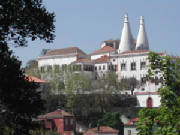|
This great palace was built for
the Portuguese Court as a summer residence through
several kingdoms. It dominates the landscape of the town
centre with its unusual chimneys, which became Sintras
landmark, and the beautiful Manuelin windows.
It is
considered the ex-libris of Sintra for its historic
meaning .
Consisting of various bodies
built during the course of successive epochs on the
so-called "Chão da Oliva", the Paço da Vila de Sintra is
one of the most important examples of regal architecture
in Portugal and for that reason is classified as a
National Monument. This gradual multiplication of
buildings, with different styles, is largely responsible
for the enigmatic enchantment of this ancient palace,
dominated by outstanding twin chimneys atop
the kitchen.
After the Reconquest, the Palace
passed into the possession of the Crown and was
considerably enlarged, not only in the reign of D. Dinis
- who in 1281 laid down that the conservation of the
Palace should be entrusted to the enfranchised Moors of
Colares -but especially in the reigns of Dom João I
(1385-1433) and D. Manuel (1495-1521).
And also,
apart from the elements of Gothic, Mudejar, Manueline
and Renaissance architecture, are the wonderful azulejos
(coloured glazed tiles) from the 15th and 16th Centuries
in various halls, terraces and in the Royal Chapel.

|
 |
| Portugaltravelers
Recommends |

Sintra: A
Glorious Eden
Malcolm
Jack
| | | | |